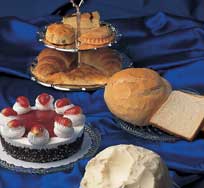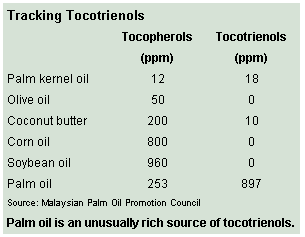
Palm oil is extracted from the fruit of the oil palm, Elaeis guineensis. Unlike many other vegetable oils, the extraction is done without using solvents. Palm oil is the leading agricultural crop of Malaysia, which is the world's largest producer. The oil, from the flesh of the fruit, is refined to remove free fatty acids, color and unwanted flavor. It can be fractionated into many grades including olein (liquid oil) and stearin (solids), depending on the solid fat level needed for functionality.
The fatty acid composition of palm oil is a mixture of 10% polyunsaturated, 40% monounsaturated and 50% saturated fatty acids. It is about 40% oleic, 10% linoleic, 45% palmitic and 5% stearic acid.

A Plethora of Possibilities
Palm oil is rich in antioxidants. These include beta-carotene, a precursor of vitamin A; and tocopherols and tocotrienols, vitamin E constituents. These scavengers of free radicals are thought to help protect people from cellular aging, atherosclerosis and cancer. Tests have shown that palm oil does not raise blood cholesterol levels. In fact, in several studies, blood cholesterol was reduced from entry-level values.In a paper supplied by the Palm Oil Research Institute of Malaysia titled, “Trans Fatty Acids Free Food Formulation Based on Palm Oil and its Products,” authors Noor Lida Habi Mat Dirn and Mohd Suria Affandi Yusoff give formulations for several trans-fat free products using palm oil fractions, combinations with other oils and interesterified oils.
Table margarines and bakery shortenings need to be smooth, with a fine crystal structure, so that they can easily be spread and mixed. Bakery shortenings impart a tender quality to baked goods and contribute to the formation of their structure during cooking. Palm oil formulations showed good baking characteristics, producing cakes that were comparable in volume, texture, structure, flavor and eating characteristics when compared to a control of commercial shortening.
Frying oils must withstand high temperatures without breaking down or polymerizing quickly, and without oxidizing and turning rancid. Some oils have to be partially hydrogenated for this purpose. However, palm oil has a moderate linoleic acid content and small linolenic acid content, two polyunsaturated fatty acids that oxidize relatively quickly, as well as a high level of natural antioxidants. Several types of palm oil and palm olein can be used successfully in frying applications, without hydrogenation.
Cocoa butter substitutes should have the snap and crunch of chocolate and a melt-in-the mouth sensation. A fat similar to cocoa butter may be made from a POP-rich mid fraction (Palmitic-Oleic-Palmitic) of palm oil mixed with another oil fraction, or it can be produced by interesterification of palm olein. Interesterification of palm oil also produces confectionery fats that can be used, for example, as a butter cream filling for cookies.
In imitation dairy products, butterfat is replaced with vegetable oil, which lengthens their shelf life. Palm oil can be used in “filled” milks as well as in coffee whiteners or coffee creamers. It also can be used in ice cream and in imitation cheese in a fat blend.
For more information:
Mohd Salleh Kassim at 310-944-3910
americanpalmoil@yahoo.com
www.mpopc.org.my
Malaysian Palm Oil Council Inc. Write in 402